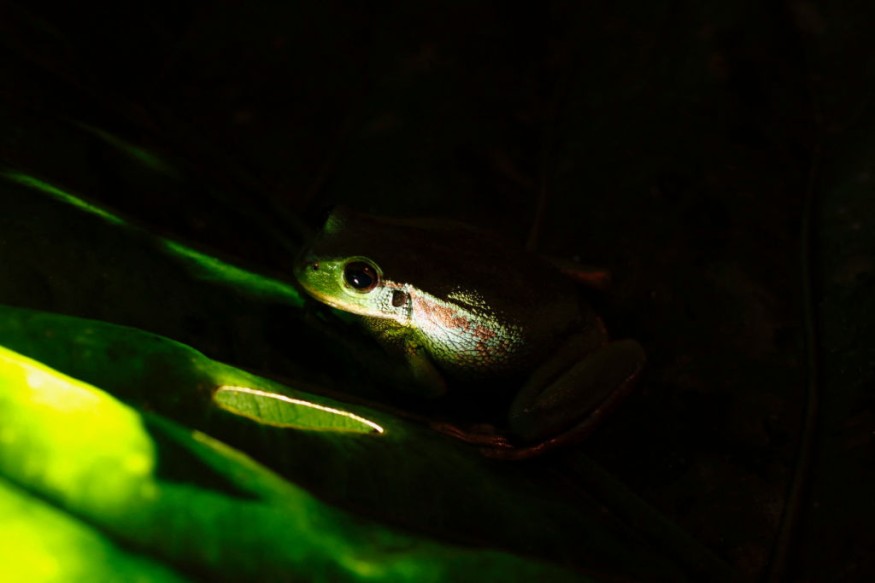
According to a recent study, South American frogs use a fluorescent compound to glow at twilight, allowing them to communicate with one another and fend off predators.
151 Species of South American Frogs Glowing
A natural wonder was announced by scientists in 2017. They discovered that South American frogs glow at twilight with a fluorescent compound, which has never been noted or observed in nature prior to the study.
The number of frog species that might emit this light was unknown at the time. A lot more has been discovered through new studies than what the earlier findings even hinted at.
Every single individual, or 528 frogs, in a survey of 151 species of South American frogs displayed some degree of fluorescence.
Fluorescence may also be used by frogs to indicate to one another and maybe ward off predators since, according to a study, it is well-matched to their vision and ecology.
Frog vision and ecology match their glowing properties!
— Courtney Whitcher (@FluoroFrogs) August 14, 2023
We added fluorescence data for 150+ frog sp. & found evidence sensory drive may underlie the evolution of this trait.
Check out this article https://t.co/RqWzNvlq5E about our new preprint out now: https://t.co/yHBUmf7K0X
Using a field study across South America, a group led by Florida State University scientist Courtney Whitcher described how they found and recorded biofluorescence patterns in tropical amphibians.
They added members of previously untested anuran groups and more than tripled the total number of species that were included in the characteristic testing. The group's findings imply that frog biofluorescence is probably used in anuran communication because there is evidence of tuning to the frog's ecology and sensory systems.
Other Creatures That Glow
In the animal kingdom, there are many glowing objects, although the cause isn't always clear.
Fluorescence is a glow that is produced when light is absorbed and then re-emitted at a different wavelength. Many species, including catsharks, salamanders, chameleons, and, strangely, Australian monotremes and marsupials, have been shown to exhibit fluorescence. Bone can glow as well, even human bone, according to a previous study.
However, the biofluorescence generated in frogs' skin appears to be distinct from that of other luminescent creatures. In South America, Whitcher and her team captured and analyzed 528 frogs, exposing them to lights that ranged from ultraviolet to visible spectrum, and documenting the outcomes.
How and Why Frogs from South America Glow
In the study, each frog exhibited a glowing response, even though some displayed as little as a 2% fluorescence. Notably, blue light resembling Earth's twilight evoked the strongest fluorescence among various wavelengths tested. This fluorescence predominantly manifested in dual visible-light peaks - one orange and another green.
Many frogs are crepuscular, thriving in twilight's dimness during dawn and dusk. Their eyes are adapted to this environment, enriched with green and blue-sensitive rod photoreceptors. Such green-sensitive rods occupy roughly 60% of certain frogs' retinas.
Also Read : Invasive Toxic Cane Toad Population Near Resort in Florida Hunted Down By Man with BB Gun
This alignment results in heightened green luminance during their peak activity, synchronized with their optimal vision. Body parts involved in inter-frog signaling, like the throat and back, exhibited the most intense glow, implying that biofluorescence aids communication.
The purpose of orange fluorescence remains uncertain, potentially linked to evolutionary byproducts or predator deterrence. However, the researchers emphasize that the ecologically significant green glow fulfills all necessary criteria.
According to scientists, biofluorescence is most noticeable during this time because it fits the perception peak demonstrated by anuran green rods in many frog species but strongly contrasts with background hues reflected during regular frog breeding hours.
Their findings motivate more studies into the role of biofluorescence in anuran communication and raise the possibility that sensory drive may have influenced the evolution of the phenomenon.
Related Article : New Species of Frog Found Under a Rock in Venezuela has Copper Eyes
© 2025 NatureWorldNews.com All rights reserved. Do not reproduce without permission.





